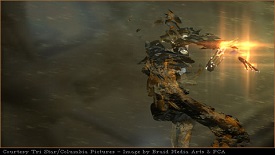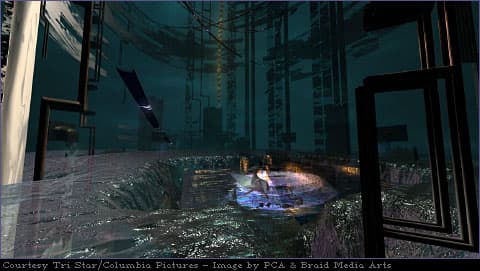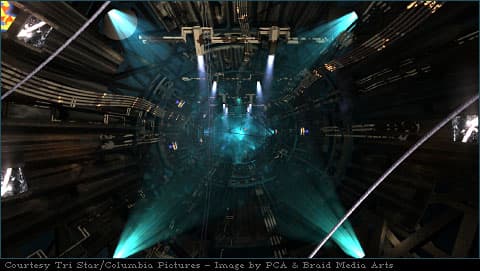




Hollywood Goes Cyberpunkby Artie Romero |
||
|
In the gritty, overpopulated future of William Gibson's vision, In this story, Johnny is in deep trouble. He has overloaded his storage capacity in order to complete "one last run," and the data he carries is the property of a murderous organization--the Yakuza, members of transnational organized crime syndicates originating in Japan. In the ensuing battle, one of the encryption images--necessary for Johnny to upload the data--is destroyed. In the climax of the story, Johnny must "hack his own brain," meaning that he must enter the computer network and Naturally, the depiction of the Internet as a physical place was a key element in the film. Sony Pictures Imageworks and Braid Media Arts were the CG firms selected for the job of depicting it. Sony was charged with visualizing Johnny's phone interface sequences, and vast overviews of the Internet. The "can-opener" sequence and the final virtual encounter were Braid's tasks, totaling almost two minutes of screen time. Digital artists Darrel Anderson of Colorado Springs, Colorado and Rick Berry of Boston had worked with Mr. Gibson on other projects. Berry created the original cover art for several of Gibson's books, including the first paperback edition of Neuromancer and the short story collection Burning Chrome. The latter contains the short story on which Johnny Mnemonic is loosely based. Anderson had created package illustrations for the Neuromancer computer game. Gene Bodio of Milford, Massachusetts based PCA was recruited by Braid to assist in the project, bringing extensive experience with the software of choice, Alias Research's PowerAnimator V5.0 for Silicon Graphics (SGI) computers. I was brought in as a "contingency" to create 2D animated bitmaps which could be applied to various 3D objects, and for other 2D manipulations. I also helped with project management in Braid's Winchester, Massachusetts studio. |
||
|
To assist with the difficult character animation, Braid utilized the Flock of Birds motion-capture system from Ascension Technology Corp., which provides magnetic tracking of up to 29 key body points. Berry performed Johnny's movements, which were recorded as motion curves. Unfortunately, the computer recording the data was hooked into a quirky ethernet system, resulting in occasional gaps in the data stream. Normally the curves provided by Flock of Birds need to be edited for smoother animation, and this bug added considerably to the workload. Alias brought a number of useful tools and effects to the production, including explosions, fog, light beams, and object glow. For proper film resolution, the frames had to be rendered very large. Many shots included elaborate textures such as Although most of Braid's work on the film was done in Alias Power Animator, a couple of shots were animated in 3D Studio on a Windows PC to utilize some of Studio's unique plug-in effects. For instance, there is a key scene in which Johnny arrives on his virtual brain plates, which resemble a stack of phosphorescent MRI images on glass. Working on a variety of Macintoshes, I used Photoshop and MetaFlo' to create animated bump maps and textures. DeBabelizer was used to convert my PICTs and TIFFs to SGI format. All the computers at Braid's studio were networked, and I used the FTP utility Fetch to easily send converted bitmaps from a Mac to the SGI Indigo2 computers for test rendering in Alias. The original textures for the encryption chip in Johnny's brain were created by Rick Berry. Typically, Berry paints in oil, then scans his painting and re-works it extensively on his Macintosh. The chip had several LED-type displays which I animated in Photoshop. I took Berry's original TIFF files and created a series of moving displays by cutting and pasting the text into different arrangements. I used Photoshop's airbrush tool to soften the edges of my clips and to add a few mysterious flashes of light. To view my animations, I used Boris Tsikanovsky's proprietary tool RealTime, which offers smoother playback and fewer blocky artifacts than Apple's QuickTime. Setting RealTime's RAM allotment at 8 megs produced almost flawless playback, even in large windows. The Valis Group's MetaFlo' was important to my work on this film. For a scene in which MetaFlo' has very good previewing, and excellent speed for final rendering. On a 40mhz Quadra, a 5-second sequence at film resolution in 24-bit color took less than 90 minutes to render. The most amazing feature of MetaFlo' is the smoothness of its rendered distortions. No matter how much an image is stretched or twisted, no "jaggies" ever appear. Since To make this idea work, I animated the expanding triangles as a series of monochrome TIFF files, and these were applied frame by frame as successive displacement maps on Johnny's face. It was necessary to blur all the images to give the waves rounded edges, so PhotoMatic was used to batch-process the images. The final result passed the weirdness test. Even today, seeing this elaborate computer animation on DVD is a thrill. Johnny Mnemonic allowed a few of us computer cowboys to actually visualize the Web of the future as a real place. Check it out! *NOTE: I used the term "cyberspace" because the word was actually originated by William Gibson, the author of the short story on which this film was based. This article was first published in 1995 and was slightly revised and updated on December 4, 2016. -- Artie Romero. |
||
















 Email us |
ARG! Cartoon Animation, LLC phone 720.989.1251 |





Copyright © 2024 ARG! Cartoon Animation™ Contact us Terms of use Privacy statement Updated 03/01/2021







 Johnny
Johnny smash through Black Ice
smash through Black Ice moving water, and some frames took up to 5 hours to render on a typical 150mhz Indigo2. For some of these scenes, Braid utilized Alias Research's large SGI rendering farm. An SGI Black Onyx supercomputer was also employed for a short period of time, and the studio was definitely warmer that November!
moving water, and some frames took up to 5 hours to render on a typical 150mhz Indigo2. For some of these scenes, Braid utilized Alias Research's large SGI rendering farm. An SGI Black Onyx supercomputer was also employed for a short period of time, and the studio was definitely warmer that November! Johnny emerges from a beam of light
Johnny emerges from a beam of light "black ice" (a virus) attacks virtual Johnny
"black ice" (a virus) attacks virtual Johnny cyberspace* is a strange place, we endeavored to give it an extremely weird look, with objects materializing and dematerializing somewhat randomly. Our goal was to avoid realism. To animate Johnny shouting, for instance, we moved radially expanding visual distortions out from Johnny's mouth, around the surface of his head. My first attempt at animating these sound waves used the "Pond Ripples" filter in Adobe Photoshop to distort Rick Berry's original map of Johnny's face. This was rejected as being too analogous to the real world. Berry suggested using triangle-shaped waves.
cyberspace* is a strange place, we endeavored to give it an extremely weird look, with objects materializing and dematerializing somewhat randomly. Our goal was to avoid realism. To animate Johnny shouting, for instance, we moved radially expanding visual distortions out from Johnny's mouth, around the surface of his head. My first attempt at animating these sound waves used the "Pond Ripples" filter in Adobe Photoshop to distort Rick Berry's original map of Johnny's face. This was rejected as being too analogous to the real world. Berry suggested using triangle-shaped waves.